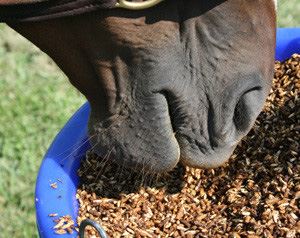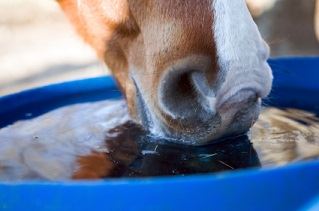Author: Kristen M Brennan, PhD, Alltech Inc.

In my first column, we covered what makes the equine digestive tract unique and how food migrates from the point of ingestion to those piles of manure we all love to scoop every day. Now that we all have a basic understanding of gastrointestinal anatomy and physiology, let’s start to talk about the basic or essential nutrients that are needed in a healthy horse’s diet.
We left the last article talking about what a nutrient is. Just to review, simply put, a nutrient is a component in food or feed that is necessary to support life. Nutrients can be further broken down into two types: macronutrients, or those required in higher levels and micronutrients, or those required in much smaller amounts (but are still important!). This time we are going to focus on macronutrients in your horse’s diet. There are three major macronutrients in your horse’s diet: water, protein and energy.
Macronutrients
Water

When I talk about essential nutrients, I always list water as number one. Often referred to as the “forgotten nutrient”, water is the most important nutrient because horses cannot live long without it. Every horse needs a constant supply of fresh, clean drinking water at all times of the day. An average 1200lb horse will drink about 5 to 10 gallons of water per a day, or about 2 quarts minimum per a pound of hay. In the summer, when horses are grazing on fresh pasture, some of this intake comes from the grass they consume. Just like people, water intake will increase with outdoor temperatures, increased exercise or during lactation and decrease in colder temperatures or with decreased exercise. Horses also may also drink less if they are sick or if they can’t find a source of water that is palatable to them.
Protein
Protein is an essential nutrient that provides your horse essential amino acids which are the building blocks for all aspects of your horse’s body from the growth and repair of muscle, bone and soft tissue to the proper functioning of the immune system. While we talk about protein in a general term as the required nutrient, its actually the individual amino acids that are so important. These amino acids are called the “essential amino acids” and horses must get them from their diet because they cannot synthesize them.
On a feed tag, protein content is defined as “crude protein”. This a common term in animal nutrition and is a calculation based on nitrogen content of the feed to estimate the actual protein content. One thing crude protein does not tell us is the actual amounts of amino acids. Just like with humans, not all protein sources are equal as they may provide different levels of individual amino acids: therefore, it’s possible for your horse to consume enough protein but not enough of individual amino acids. Legumes like alfalfa and soybean meal are high quality sources of protein in equine diets.
One of the biggest challenges is that we are just now starting to understand how much of each essential amino acid is required in the diet. Luckily equine nutrition researchers are contributing valuable studies in this area that will eventually tell us this valuable information. One thing we do understand is that the amount of protein a horse can make from amino acids it consumes is limited by the amino acids that runs out first. If you think about a bucket of water with holes at various heights up the side, you can only fill the bucket as high as the lowest hole. Same thing goes for protein synthesis: you can only make as much protein (water in the bucket) as the amino acid that runs out first because of the lowest supply (the lowest hole in the bucket). Luckily, we do know that the most likely to run out first (called the limiting amino acid) is lysine. Therefore, you may see additional lysine listed on your feed tag below crude protein.
Energy

While technically not a nutrient because horses can’t consume energy per say, energy is essential for supporting life. Horses have two main sources of energy: carbohydrates and fats. Just like most other nutrients, energy needs increase with growth, exercise, gestation and lactation in horses.
Carbohydrates are the main energy source in equine feeds and can be further broken down into structural and nonstructural fractions. Structural carbohydrates, like fermentable fiber sources, are broken down in the hindgut and fermented by microbes to release energy in the form of volatile fatty acids. While we think of forages like pasture and hay when we think of fiber, feeds like beet pulp can also be great sources. Nonstructural carbohydrates like starch and sugar can be thought of as the “quick acting” carbohydrates-the are easily broken down and absorbed through the small intestine into the bloodstream as glucose. Both forages and grains contain nonstructural carbohydrates, but levels are highest in cereal grains like corn, oats and barley. While starches and sugars often get a bad reputation, it’s important to note that in a normal, healthy horse, they are a great source of energy.
For a long time, it was thought that horses could not use fat an energy source but research has shown that horses tolerate a fairly high level of fat in their diet. Fats are energy dense (more than twice that of carbohydrates), are easily digestible and an economic way of increasing the energy content. Traditionally most concentrates were formulated to be low fat, but more recently there has been a trend for higher fat feeds containing up to 12% fat. One thing we are still trying to understand is the importance of the form of fats-namely the omega 3, 6 and 9 fatty acid groups. These fats have been shown to have an important role in the health of other species, but research is still on going in horses.
Hopefully this gives you a better understanding of macronutrients and why they are important in your horse’s diet. Next time we’ll visit the micronutrients-the small but mighty nutrients that are so essential to health.
